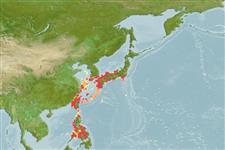>
Eupercaria/misc (Various families in series Eupercaria) >
Cepolidae (Bandfishes) > Cepolinae
Etymology: Acanthocepola: Greek, akantha = thorn + Latin, cepulla, cepa = onion.
More on authors: Temminck & Schlegel.
Environment: milieu / climate zone / depth range / distribution range
Écologie
marin; saumâtre démersal; profondeur 3 - 50 m (Ref. 90102). Tropical; 37°N - 10°N, 119°E - 141°E (Ref. 56297)
Western Pacific: Indonesia to the Philippines; north to Japan, south to Australia.
Taille / Poids / Âge
Maturity: Lm ? range ? - ? cm
Max length : 40.0 cm TL mâle / non sexé; (Ref. 559)
Identified by the spaced series of pupil-sized red spots along upper sides (Ref. 48635).
Inhabits the shallowest water, compared to other cepolids. Lives on muddy substrates, deep as well as in shallow protected estuaries (Ref. 48635). Caught by dredge, but not valued as food fish (Ref. 559, 637).
Life cycle and mating behavior
Maturities | Reproduction | Spawnings | Egg(s) | Fecundities | Larves
Allen, G.R. and M.V. Erdmann, 2012. Reef fishes of the East Indies. Perth, Australia: Universitiy of Hawai'i Press, Volumes I-III. Tropical Reef Research. (Ref. 90102)
Statut dans la liste rouge de l'IUCN (Ref. 130435)
Menace pour l'homme
Harmless
Utilisations par l'homme
Outils
Articles particuliers
Télécharger en XML
Sources Internet
Estimates based on models
Preferred temperature (Ref.
123201): 17.2 - 28.6, mean 21.5 °C (based on 66 cells).
Phylogenetic diversity index (Ref.
82804): PD
50 = 0.5625 [Uniqueness, from 0.5 = low to 2.0 = high].
Bayesian length-weight: a=0.00513 (0.00222 - 0.01187), b=2.82 (2.61 - 3.03), in cm total length, based on LWR estimates for this (Sub)family-body shape (Ref.
93245).
Niveau trophique (Ref.
69278): 3.4 ±0.4 se; based on size and trophs of closest relatives
Résilience (Ref.
120179): Milieu, temps minimum de doublement de population : 1,4 à 4,4 années (Preliminary K or Fecundity.).
Fishing Vulnerability (Ref.
59153): Low to moderate vulnerability (30 of 100).
